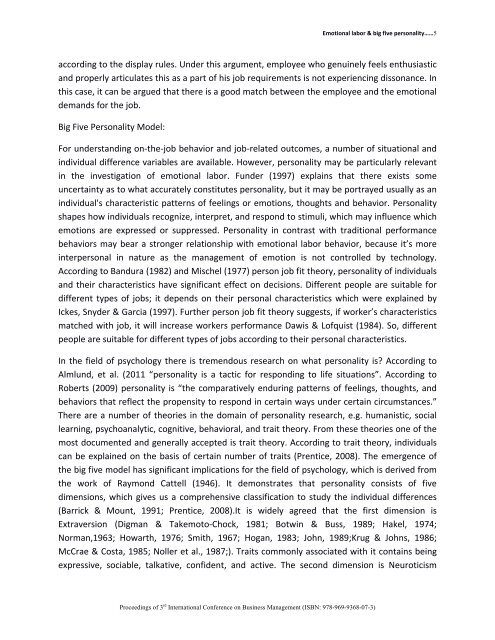Emotional Labor & Big Five Personality Model - CGR - University of ...
Emotional Labor & Big Five Personality Model - CGR - University of ...
Emotional Labor & Big Five Personality Model - CGR - University of ...
Create successful ePaper yourself
Turn your PDF publications into a flip-book with our unique Google optimized e-Paper software.
<strong>Emotional</strong> labor & big five personality……5according to the display rules. Under this argument, employee who genuinely feels enthusiasticand properly articulates this as a part <strong>of</strong> his job requirements is not experiencing dissonance. Inthis case, it can be argued that there is a good match between the employee and the emotionaldemands for the job.<strong>Big</strong> <strong>Five</strong> <strong>Personality</strong> <strong>Model</strong>:For understanding on-the-job behavior and job-related outcomes, a number <strong>of</strong> situational andindividual difference variables are available. However, personality may be particularly relevantin the investigation <strong>of</strong> emotional labor. Funder (1997) explains that there exists someuncertainty as to what accurately constitutes personality, but it may be portrayed usually as anindividual's characteristic patterns <strong>of</strong> feelings or emotions, thoughts and behavior. <strong>Personality</strong>shapes how individuals recognize, interpret, and respond to stimuli, which may influence whichemotions are expressed or suppressed. <strong>Personality</strong> in contrast with traditional performancebehaviors may bear a stronger relationship with emotional labor behavior, because it’s moreinterpersonal in nature as the management <strong>of</strong> emotion is not controlled by technology.According to Bandura (1982) and Mischel (1977) person job fit theory, personality <strong>of</strong> individualsand their characteristics have significant effect on decisions. Different people are suitable fordifferent types <strong>of</strong> jobs; it depends on their personal characteristics which were explained byIckes, Snyder & Garcia (1997). Further person job fit theory suggests, if worker’s characteristicsmatched with job, it will increase workers performance Dawis & L<strong>of</strong>quist (1984). So, differentpeople are suitable for different types <strong>of</strong> jobs according to their personal characteristics.In the field <strong>of</strong> psychology there is tremendous research on what personality is? According toAlmlund, et al. (2011 “personality is a tactic for responding to life situations”. According toRoberts (2009) personality is “the comparatively enduring patterns <strong>of</strong> feelings, thoughts, andbehaviors that reflect the propensity to respond in certain ways under certain circumstances.”There are a number <strong>of</strong> theories in the domain <strong>of</strong> personality research, e.g. humanistic, sociallearning, psychoanalytic, cognitive, behavioral, and trait theory. From these theories one <strong>of</strong> themost documented and generally accepted is trait theory. According to trait theory, individualscan be explained on the basis <strong>of</strong> certain number <strong>of</strong> traits (Prentice, 2008). The emergence <strong>of</strong>the big five model has significant implications for the field <strong>of</strong> psychology, which is derived fromthe work <strong>of</strong> Raymond Cattell (1946). It demonstrates that personality consists <strong>of</strong> fivedimensions, which gives us a comprehensive classification to study the individual differences(Barrick & Mount, 1991; Prentice, 2008).It is widely agreed that the first dimension isExtraversion (Digman & Takemoto-Chock, 1981; Botwin & Buss, 1989; Hakel, 1974;Norman,1963; Howarth, 1976; Smith, 1967; Hogan, 1983; John, 1989;Krug & Johns, 1986;McCrae & Costa, 1985; Noller et al., 1987;). Traits commonly associated with it contains beingexpressive, sociable, talkative, confident, and active. The second dimension is NeuroticismProceedings <strong>of</strong> 3 rd International Conference on Business Management (ISBN: 978-969-9368-07-3)
















